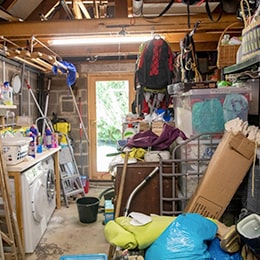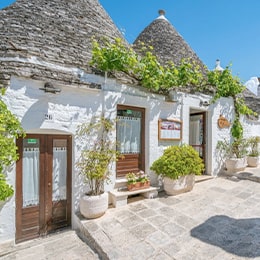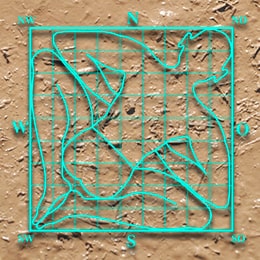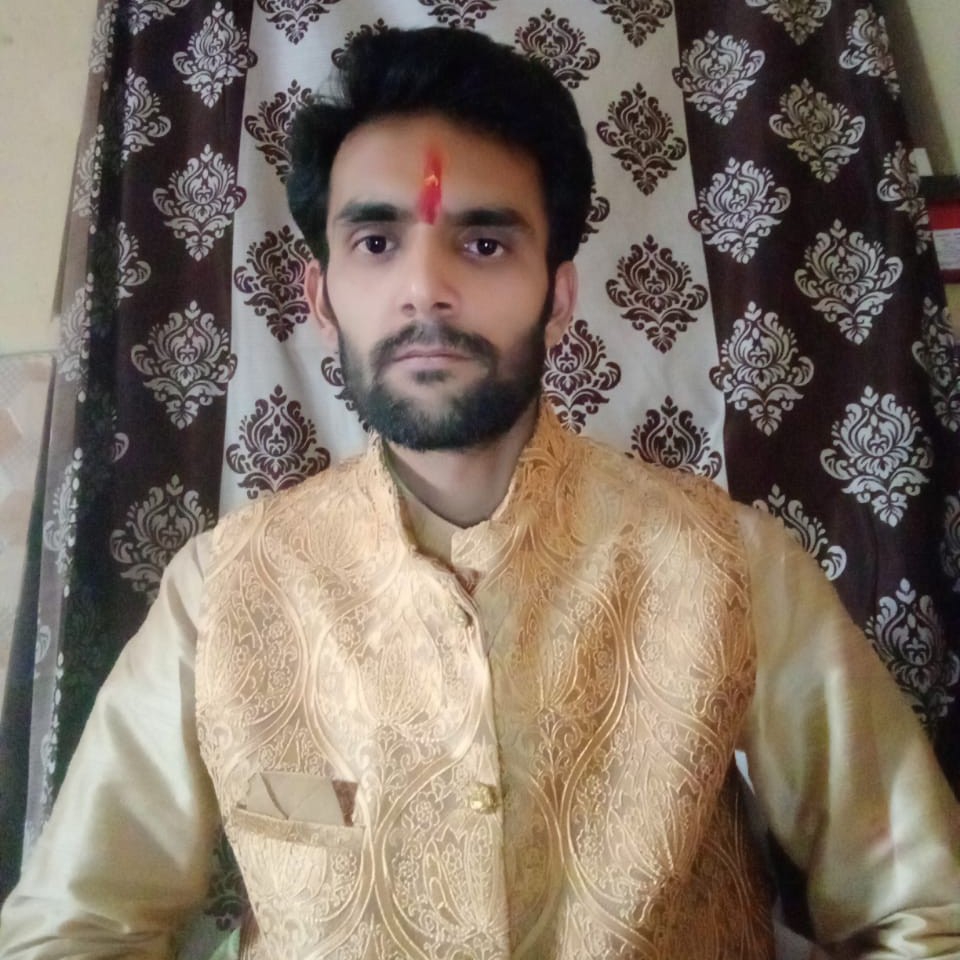Vastu Deva or Vastu Purush
Vastu Purush is considered to be the main diety who is responsible for providing peace, happiness and prosperity in any constructed building whether it be dwelling houses or commercial complexes. The worship of VastuPurush is essential al the time of laying foundation and entering into a new premise. He is required to make offerings for his blessings.
Vastu devata or Vastu purush occupies an extremely important position in vastu construction. He is the main deity of the house. According to the shastras and puranas, once lord Shiva was engaged in a fierce battle with 'Andhakasur' daitya. During this battle some drops of Shivji's perspiration fell on the earth and an extremely huge and terrifying giant rose from them. He started terrorizing and killing the devatas. Then all the devatas got together and caught him and pressed him down on the earth with his face downwards and sat down on him to prevent him from rising again.
To pacify him they gave him a boon that he will be worshipped at all the auspicious ceremonies. All the devatas reside on his body and for this reason he is known as the vastu purush. All the wise people worship him. Whoever does not worship him faces hurdles and untimely death.
Vastu purush lies on the ground in a particular posture as shown in the figure. His head is always in the 'Ishan kona' while his feet are in the 'Nairritya kona'. The soles of his feet keep touching each other.
His knees and elbows almost touch each other and remain in the Agneya and the Vayavya kona.
Worship of Vastu Puja
When should the Vastu purush be worshipped
He is mainly worshipped at three occasions :
- First at the beginning of house construction
- Second at the main door construction
- Third at the griha pravesh after completion of the house
He is also worshipped at :
- Yagyopaveet or upanayan ceremony
- Marriage ceremony
- Birth of a son
- Havan and Yagyas
He is also worshipped under special conditions :
- Reconstruction of an old door
- Reconstruction of a burnt down house
- Re-entering a house where the women had remained ill or were always fighting
- Re-entering a house which was surrounded by calamities
Worshipping Vastu devata gets his blessings and ushers in peace and happiness
Vastu Purush and Vastu Peethas
Karma Kanda advocates installation of different types of Vastu peethas according to the purpose of construction. Vastu purush is imagined on the area on which the house is to be constructed. In this manner we can have vastus starting from one 'pada' up to one thousand 'padas'.
Vastu Rajavallabha states :
ग्रामें भूपति मंदिरे च नगरे पूज्यः चतुःषष्टिके |
एकाशीतिपदै समस्त भवने जीर्णो नवाद्धं शर्केः ||
प्रसारे तु शतांशकैः तु सकले पूज्य तथा मण्डपे |
कू पेषझनवचतुभाग-साहिनों वाण्यां तडागे वने ||
The above mentioned shlokas states that one should worship 64 pada vastu for a village, town or a palace, 81 pada vastu for a residential house, 49 pada vastu for an old door, 100 Pada vastu for all types of mandapas and mansions, 144 or 194 pada vastu for a well, pond or a water body.
The shastras also mention:
दुर्गा प्रतिष्ठा विषये निवेशे तथा महार्चासु च कोटि होते |
मेरौच राष्ट्रेष्वपि सिद्धलिंगे वास्तुसहस्त्रोण पदे प्रपूज्यः ||
For building a country or a capital or a city etc, 1000 talika vastu peetha should be worshipped. Similarly for the “Pratishtha” of Durga ji and of a 'Siddha' Shivalinga also, 1000 talika Vastu peetha should be worshipped.
Brahma Sthan
The Brahma sthan is considered to be the centre of the plot. It is the focal point of all the energy. This is one of the most important points of consideration in Vastu. Brahmasthan of the vastu purush is the area around the naval, heart, lungs, stomach, secret parts and the thighs. The same principle applies to the plot also. Because such sensitive body parts of the Vastu purush are located in the brahma sthan, this place should be kept open and free from any kind of irritant like weight, pillar and the like. If the residents of the house want to live happily, then they should not construct anything in the brahma sthan. Brahma resides in the following manner in the plot.
| Padas of Brahma in the centre | |
|---|---|
| Pada | Brahma in the Centre |
| 64 Padas | 4 Padas |
| 81 Padas | 9 Padas |
| 100 Padas | 16 Padas |
| 144 Padas | 24 Padas |
| 169 Padas | 25 Padas |
| 196 Padas | 32 Padas |
| 1000 Padas | 100 Padas |
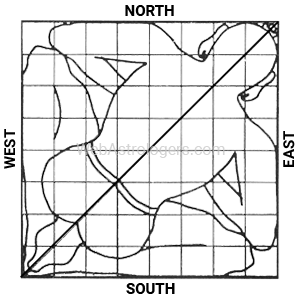
Vastu Purush
The given figure shows that every part of the plot is controlled by some body part of the Vastu purush.
Vastu and the Gods
Different gods represent different body parts of the vastu purush.
According to the Shastras :
ईशा मुघ्नि समाश्रिता श्रवणयोपर्जच नामादितिः |
आपतस्य गले तदंशयुगले प्रोक्तों जयदूचारितिद |
उक्तावर्णत-भधरौ स्तनयुगे स्यादापवत्सो हदि |
पंचेंद्रादि सुराइच दक्षिणभुजे वामे नागादभः ||
सावित्राः सविताच दक्षिण करें वामे दस्वयंरूद्रतः
मृत्यु मैत्रागणस्तथारू विषये स्मान्नागिनपुष्ठे विधिः ||
मेट्रे शुक्र-जयौच जातु युगले तौ वाहिन-रोगौस्मृतौ ||
पूषानन्दिइच सप्तादि बुधार अल्पो पदों पैतृकाः ||
मैरौच राष्टेष्वपि सिद्धलिंगे वास्तुसहस्त्रोण पदे प्रपूज्यः ||
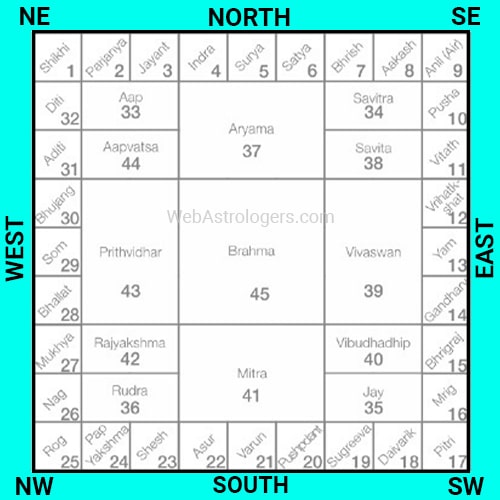
The gods are placed in the body of the Vastu purush in the following manner considering that he is lying face down.
| Organs of Vastu Purush and the places of Deities | |
|---|---|
| Body Part | God |
| Head | Shiva |
| Both Ears | Parjanya – Diti |
| Above Throat | Apadeva |
| Both Breasts | Ayarma - Prithwidhar |
| Both Shoulders | Jaya - Aditi |
| Above the Heart | Apavatsa |
| Right Hand up to Wrist | Savitra - Savita |
| From Right Elbow to the Wrist | Rudra - Dudradas |
| Thigh | Mrityu - Mitra |
| Behind Naval | Brahma Upastha |
| Reproductive Parts | Indra –Jaya |
| Above Both Knees | Agni, Roga |
| Blood Vessel of One Leg | Nandi, Sugreeva, Asur, Kshona, Pusha, Varun, Papa yakshma |
| Both heels | Pitra |
Griha vastu comprises of 81 pada vastu chakra. 45 gods reside in these 81 padas. Brahma ji occupies the 9 padas of the central portion, 32 gods reside in the corners and 13 gods reside in the centre. Their names and mantras are as follows:
| Gods and Mantra | ||
|---|---|---|
| S.No. | Name | Mantra |
| 1. | Shikhi (Isha) | Om Shikhye Namah |
| 2. | Parjanya | Om Parjanye Namah |
| 3. | Jayanta | Om Layantaya Narnah |
| 4. | Indra | Om Kulishyudhaya Namah |
| 5. | Surya | Om Suryaya Namah |
| 6. | Satya | Om Satyaya Namah |
| 7. | Bhrasha | Om Bhrashase Namah |
| 8. | Antariksha (Akash) | Om Akashaye Namah |
| 9. | Anila (Vayu) | Om Vayave Namah |
| 10. | Pusha | Om Pushaya Namah |
| 11. | Vitatha | Om Vitathaya Namah |
| 12. | Brihatkshta | Om Brihatkshtaya Namah |
| 13. | Yama | Om Yamaya Namah |
| 14. | Gandharva | Om Gandharyaya Namah |
| 15. | Bhringaraj | Om Bhringarajaya Namah |
| 16. | Mriga | Om Mrigaya Namah |
| 17. | Pitra | Om Pitre Namah |
| 18. | Dauvarika | Om Dauvarikaya Namah |
| 19. | Sugreeva | Om Sugreevaya Namah |
| 20. | Pushpadanta | Om Pushpadantaya Namah |
| 21. | Varuna | Om Varunaya Namah |
| 22. | Asura | Om Asuraya Namah |
| 23. | Shesha | Om Sheshaya Namah |
| 24. | Papa Yakshma | Om Papa haraya Namah |
| 25. | Roga | Om Rogaharaya Namah |
| 26. | Naga (Aahi) | Om Ahiye Namah |
| 27. | Mukhya | Om Mukhye Namah |
| 28. | Bhallat | Om Bhallataya Namah |
| 29. | Soma (Kubera) | Om Somaya Namah |
| 30. | Bhujanga (Sarpa) | Om Sarpaya Namah |
| 31. | Aditi | Om Aditaye Namah |
| 32. | Diti | Om Ditiye Namah |
| 33. | Aap | Om Aapye Namah |
| 34. | Savitri | Om Savitre Namah |
| 35. | Jaya | Om Jayaya Namah |
| 36. | Rudra | Om Rudraya Namah |
| 37. | Ayarma | Om Ayarmaya Namah |
| 38. | Savita | Om Savitaye Namah |
| 39. | Vivswan | Om Vivaste Namah |
| 40. | Vibudhadhip | Om Vibudhadhipaya Namah |
| 41. | Mitra | Om Mitraya Namah |
| 42. | Rajayakshma | Om Rajayakshmye Namah |
| 43. | Prithwidhar | Om Prithwidharaya Namah |
| 44. | Apavatsa | Om Apavatsaya Namah |
| 45. | Brahma | Om Brahmaya Namah |
Marma Sthan
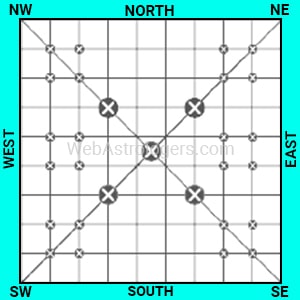
Marma Sthan
Marma sthan falls within the Brahma sthan, so nothing should be constructed in this place, otherwise the residents will suffer because of problems related to health, wealth, mind and spirituality.
This figure shows the marma sthan denoted by the dots.
Invocation and installation of Vastu purush
Vastu shanti is essential for peace, prosperity and happiness of the house. Vastu purush is the protector of every house. For vastu shanti a picture or idol of Vastu purush should be installed at the right spot in the East direction. However Sun's transit position should be noted for getting the best results.
| Sun's Transit & Position of Vastu Purush | |
|---|---|
| Sun transitting in | Install Vastu purush In |
| Taurus, Gemini, Cancer | NE Corner |
| Leo, Virgo, Libra | SW Corner |
| Scorpio, Sagittarius, Capricorn | NW Corner |
| Aquarius, Pisces, Aries | SE Corner |
Invocation, installation and worship of vastu purush protects the owner from mishaps and misfortune.
Vastu Stuti mentions :
सशैल सागरां पृथ्वी यथावहसिमूर्धनि |
तथा मां वह कल्याण संपद् संतति भिः सह ||
The manner in which you bear the load of the earth with all her mountains and oceans, similarly please protect my home, my children and my wealth. This is the prayer to Vastu purush.
They say that all the time vastu purush keeps on saying 'Tathastu'. For this reason one should never curse or speak badly in the house. One should always speak nicely and speak about auspicious things, so that auspicious things may happen in the house. Never say that there is no food and water in the house. Suppose vastu purush hears this and says 'Tathastu', then really the food of the house may get finished and hard times may follow. For this reason one should offer 'Naivedya' or prasad to vastu purush daily. If not possible then offer atleast on poornima and amavasya days. A good result will be observed within six months.












